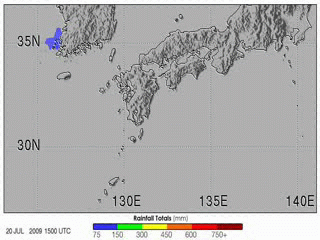ගොනුව:Heavy Rains in Southern Japan.gif
Heavy_Rains_in_Southern_Japan.gif (320 × 240 පික්සල, ගොනු විශාලත්වය: 8.35 මෙ.බ., MIME ශෛලිය: image/gif, වලිත, 268 රාමු, 8.0තත්)
ගොනු ඉතිහාසය
එම අවස්ථාවෙහිදී ගොනුව පැවැති ආකාරය නැරඹීමට දිනය/වේලාව මත ක්ලික් කරන්න.
| දිනය/වේලාව | කුඩා-රූපය | මාන | පරිශීලක | පරිකථනය | |
|---|---|---|---|---|---|
| වත්මන් | 21:56, 31 ජූලි 2009 |  | 320 × 240 (8.35 මෙ.බ.) | Originalwana | {{Information |Description={{en|1=The 2009 summer monsoon brought torrential rains to south western Japan in July. This animatin shows rainfall estimates for southern Japan and the surrounding region from July 20–27. The most prominent feature is a larg |
ගොනු භාවිතය
පහත දැක්වෙන පිටුව විසින් මෙම ගොනුව භාවිතා කෙරෙයි:
ගෝලීය ගොනු භාවිතය
පහත දැක්වෙන අනෙකුත් විකියන් මගින් මෙම ගොනුව භාවිතා කරයි:
- cs.wikipedia.org හි භාවිතය
- en.wikipedia.org හි භාවිතය
- fi.wikipedia.org හි භාවිතය
- id.wikipedia.org හි භාවිතය
- ja.wikipedia.org හි භාවිතය
- ms.wikipedia.org හි භාවිතය
- te.wikipedia.org හි භාවිතය
- uk.wikipedia.org හි භාවිතය
- vi.wikipedia.org හි භාවිතය
- www.wikidata.org හි භාවිතය
- zh.wikipedia.org හි භාවිතය


